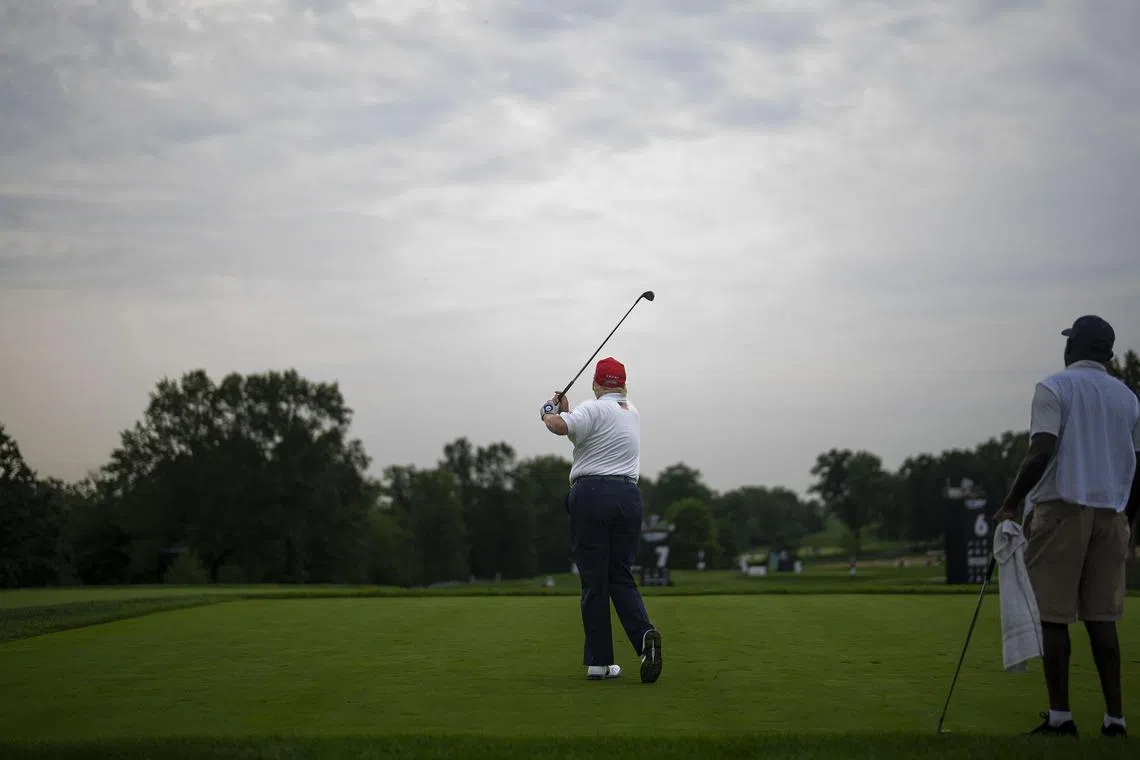For US presidents, golf is a refuge. For the Secret Service, it can be a headache
Sign up now: Get ST's newsletters delivered to your inbox

Trump usually plays his own courses, some of which have lately hosted tournaments for the Saudi-backed LIV Golf league.
PHOTO: NYTIMES
Follow topic:
WASHINGTON - Then President Ronald Reagan had gone to Augusta National Golf Club in 1983 for a break: He would stay in a cottage formerly favoured by Dwight D. Eisenhower and play the course renowned as the home of the Masters Tournament.
Then, a man rammed a pickup truck through a gate and headed towards the pro shop, where he took hostages and demanded to talk to Mr Reagan.
The episode ended after about two hours, with the president and the hostages unhurt. But Mr Reagan decided his time as the US’ golfer in chief was largely done.
“Playing golf is not worth the chance that someone could get killed,” he said, according to Mr Joseph Petro, a long-time member of Mr Reagan’s protective detail who recounted the incident in his 2005 book, Standing Next To History: An Agent’s Life Inside The Secret Service.
Mr Reagan rarely played again.
Most recent American presidents have embraced golf as a bipartisan tradition – a head-clearing, backslapping escape where a president is just as likely as anyone else to be betrayed by a putter.
But just as the Reagan episode prompted the White House to rethink whether presidential golf rounds invited unnecessary risks, Sept 15’s apparently thwarted assassination attempt on former president Donald Trump
Presidents and their Secret Service agents have been trying for decades to balance security risks with the need for sporting refuges.
But Trump’s approach to golf – including his frequency of play and his overt preferences for a handful of courses – has posed especially steep challenges for the Secret Service, which gets nervous when someone it guards settles into predictable patterns.
After Sept 15’s possible attempt at Trump International Golf Club West Palm Beach, the Secret Service’s acting director privately told Trump that the agency would need to take significant new steps to protect him if he continued to play.
The warning from the agency, which deploys fewer resources for former presidents than it does an incumbent, raised the possibility that Trump could adjust where or how often he plays.
Trump usually plays his own courses, some of which have lately hosted tournaments for the Saudi-backed LIV Golf league.
Some courses pose greater risks than others. At one near Washington, for example, boaters have drifted past on the Potomac River within sight of Trump. And the course in West Palm Beach, Florida, is close to public roads.
Other properties are more isolated, with fewer obvious opportunities for a would-be assailant to draw close to the former president.
But they are still golf courses with few fortified shelters.
Trump typically drives his own cart when he plays, and his courses generally remain open when he is nearby, with players and other visitors free to gawk at, and often approach, the former president.
He is prone to interrupting his rounds to sign autographs, pose for photographs and hold rolling news conferences to inject himself into the national conversation. (At the Virginia course in 2023, for example, he approached a reporter for The New York Times, his iPhone in hand, to show that he was on the line with Mr Kevin McCarthy, who was then the House Speaker and struggling with a debt-ceiling debate.)
Sitting and former presidents, who get lifetime protection from the Secret Service, have usually taken lower-profile approaches to golf – whether for security or to blunt the political risks of playing a sport often linked with exclusivity. (There is also the danger of a wayward shot becoming comedic fodder for the masses.)
President Joe Biden has only sporadically played since taking office, which did not keep him and Trump from squabbling on the debate stage in June over who was the superior golfer.
Former president Bill Clinton was an irrepressible golfer who relished how his office made him an appealing playing partner.
Professional players were eager to join him and offer advice. Near the end of Mr Clinton’s final term, Trump invited him to join one of his clubs; he accepted.
Decades earlier, before former president Gerald Ford started hosting pro- am tournaments, Dwight Eisenhower was the president who seemingly could not stop playing – so much so that his immediate successor John F. Kennedy, a more skilful golfer than many of his presidential counterparts, was self-conscious about being seen on a course.
“Approaching the ninth green, the president spotted a whole raft of photographers just kind of over the crest of the green,” Mr Paul Fay, a Kennedy friend who served in his administration, remembered in an oral history for the Kennedy Library.
“He just turned at that time and said, ‘I just don’t want to have my picture taken, one of the first things of my administration, playing golf. I’m going to leave.’”
Trump has shown far less reserve, particularly since he left the White House. There have been times, though, when he has seemed to savour the game’s pleasures or the moments of relative calm it offered.
On that much, he and Mr Clinton might have common ground.
“Even though you’ve got these Secret Service people all around us,” Mr Clinton once told Golf Digest, “this is the nearest I ever am to being like a normal person.” NYTIMES

